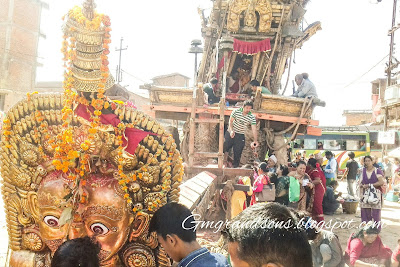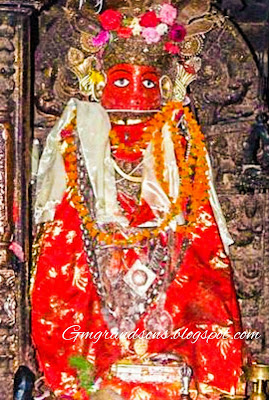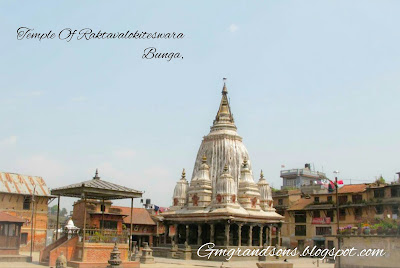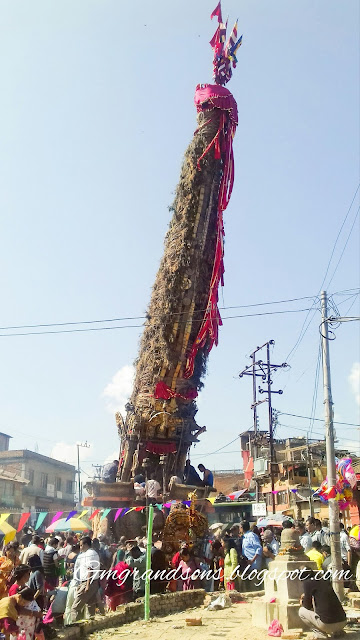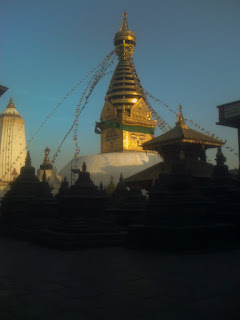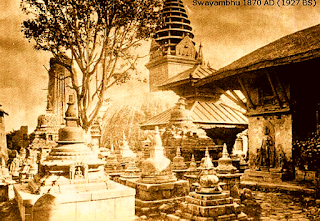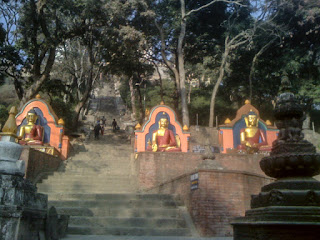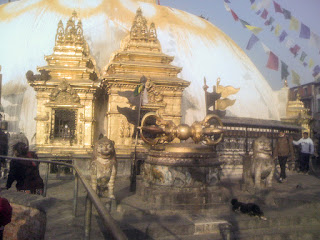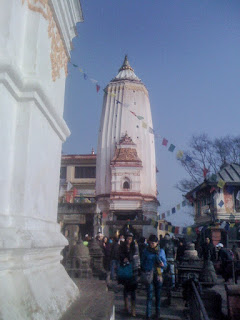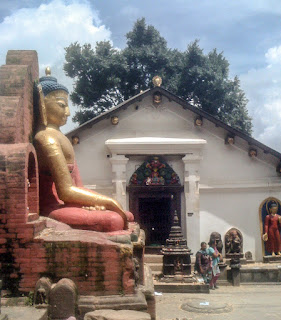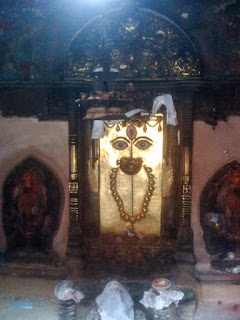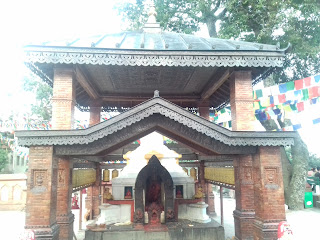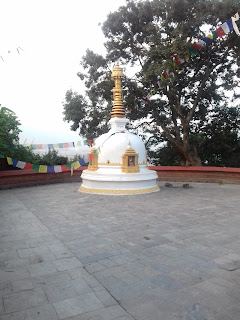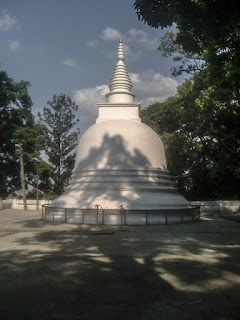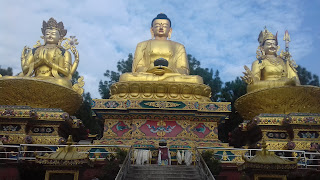RATO MACHINDRANATH:
BUNGA~DYO; THE RAKTAVALOKITESHVARA.
Bungadyo; the god of rice grains also known as the harbinger of rainy season among the Newar community of Kathmandu valley from the city of Amarapuri (Bungamati) also familiarly called as Red Karunamaya by Kathmandu Newars, Avalokiteshvara by Buddhists but highly popular by the name Rato Machindranath being Nepali as a national language.
It's been said that to liberate the grief of living beings there are 108 forms of Lokeshvara descended to Earth and to defence the misfortune and disaster of this Universe Lokeshvara who is also incorporated to Hindu's most reverred god Lord Shiva had incarnated in various forms from the begining of era till now at different realms is counted to 360 forms. Among them Raktavalokiteshvara (Rato Machindranath) is one of the 4 main Karunamayas from the Kathmandu valley who procured his birth as the prince on the Yakshya lok 'Kamaru Kamakshya'. The yearly chariot pulling ceremony of Rato Machindranath or Rato Karunamaya (the Compassionate one in red color.) which begins on the 4th day of bright fortnight of the month 'Bachala' according to Newar's Lunar calendar is one of the indispensable & spiritual ceremony of Kathmandu valley.
THE LEGEND OF RAKTAVALOKITESHVARA
(RATO MACHINDRANATH).
(RATO MACHINDRANATH).
According to legends at the starting of medieval era, one of the oldest city of Nepa (Kathmandu valley was named as Nepa at medieval era) was throned by a valorous with great virtue and pious Lichhavi king Gunakamadeva. Having a palace in the beautiful city Khwopa (now known as Bhaktapur), he is the man of his words and treats his citizens as his own children. He has a beautiful daughter named Gunalakshmi possessed with all the 32 auspicious features. When the princess grew younger one night god Narayana(Vishnu) came to her dream and made her familiar about who she is and how he will visit the king to ask for her hand to marry.
The next evening a pack of wolves leaded by a beautiful white wolf came near by the gate of palace and began to howl. They were crying with so much noise. The king frightened of misfortunes called his astrologers to know about the reason. Astrologers found nothing bad and suggest the king to arrange a talk with wolves. King with his astrologers called the leader of the wolves and asked the reason of their visit to palace. The white wolf replied that he was there to marry king's daughter as the king had said long ago to give her to an wolf. King Gunakamadeva became amazed to hear that taking him way back to his memory while the princess was small kid who made an unbroken cry that no-one was able to calm her. At that moment the king in anger had said to his daughter that he will espouse her to an wolf which stopped her crying. King felt sorry for himself cause he is the man of words but he can't give his daughter's hand to an wolf. Knowing this incident princess Gunalakshmi came to confront the situation with her parents. She told them that she already knew about it and convinced her parents not to worry about her.
After having the words from princess king Gunakamadeva called his councellors and making all the citizens aware about it he held a huge marriage ceremony of his daughter with an wolf. After completing all the rituals king gave permission to depart his daughter and son in law from the palace. Both of the newly weds get into the chariot then four of the wolves among the pack of wolves nipped the rope of chariot and pulled it to their destination followed by king's porters carrying the presents gifted by king. After passing a long way from the palace they were at near by a cave of the mountain. The wolves pulled the chariot inside the cave and the porters folowed them which leads them to an beautiful unbelievable golden palace carved with gems. Suddenly all the wolves vanished in air and the white wolf get it's form into god Narayana (god Narayana is the next name of god Vishnu who held ten incarnations for the welfare of morality. It is said that the most venerated mystic syllable ॐ pronounced as AUM is embodied with Brahma, Vishnu and Mahesh.) & sat on the throne of the palace with his bride. Gods with Rishi-Muni (saint) from heaven began to appear there. They organize marriage ceremony that had to be held at groom's house with an huge feast. After finishing all the rituals god Narayana adieu the king's porters by presenting golden dishes in which the feast was served to them. Porters came back to palace filled with pleasure, they explained all the scene inside the cave to the king. King being delighted after hearing it decided to visit god Narayana. The king with his councellors and some of his citizens went to worship god Narayana guided by a leader of porters. They got inside the cave but there wasn't any entrance to the golden palace. Peoples and councellors began to search for a way here and there. When the king and leader of the porters were seperated from others they saw a way in and get inside the palace. God Narayana appeared as they came inside; king Gunkamadeva became so delighted to have a view of god, he worshipped god Narayana. God being pleased with the devoution & virtue of king Gunkamadeva asked the king about his wish to be granted. The king thought the boon must be in favour of all his citizens came out of cave having the permission from god and counselled with his councillors and citizens over there. After deciding what they need king went into the golden palace and made his wish to god that he want rice crop to fertile in his kingdom. God Narayana told the king to get the rice seed from the kingdom of Magadha and suggest him when and how to plant it and fade away. King Gunakamadeva came out, said exactly what he was told to his citizens. People did as they were suggested the valley was beautified with rice plant. Sooner the plant began to bear the rice seed. As season passed the crops began to ripe. Peoples were so happy to harvest rice crops for the first time but found that the grain was empty, it's just an husk there wasn't any rice grain inside it. Disheartened people visited the king and called their misfortunes to king. The king being complicated to solve the problem thought for visiting God Narayana once again. He prepared the worship plate and went to visit the god. God Narayana appeared, listened king's problem and mused what's gone wrong? God Narayana found that a part from the 32 auspicious body parts of Arya Avalokiteshvara Karunamaya will born as the creator of rice grains in Yakshya lok 'Kamuni Kamakshya' (Demon's Kingdom) for the elimination of the sufferings over there and without making the part of Avalokiteshvara visit to the Valley it's impossible to make rice crops to bear rice grain inside the husk. So he said 'sorry' to the king for all the problems. God Narayana told king that the creator of the rice grain was going to born as a prince in Yakshya lok for the queen of the demons being one of the favoured pious devotee of Lord Avalokiteshvara, who was practising all the fastings with the goodness of morality as the attainments of propriety and bodhicharya that Avalokiteshvara in the manifestation had taught the demons of Kamaru Kamakshya to liberate them from the sins they made and to eliminate the sufferings. So as to solve the problem of Kathmandu valley it is essential to make the prince visit valley. God Narayana promised that he will help to make it happen. God also said to king that the king won't be able to see those days and suggest the king not to loose faith and retain his virtues with new practise of fasting to have favour from god Avalokiteshvara. King came back and told his citizens what the god had said to him and done same as the god suggested him for the remaining of his life.
Time passed on as do decades and decades. As aforesaid by God Narayana a part of Avalokiteshvara was borned as a youngest prince among 500 children of demon king Sashi of Kamaru Kamakshya. By knowing this the master of yoga, the highly learned tantrik guru Gorakhnath knowing his promise to king Gunakamadeva in his actual form of god Narayana made his way to Kathmandu valley. Gorakhnath is a great saint who was given birth as a baby from a dough of cow dung with an spirit of god Narayana by Arya Avalokiteshvara in the manifestation of an sage for one of his childless devotee Sumati from the city of Gaud (one of the ancient city which is now in India) but Sumati failed to possess it. So Arya Avalokiteshvara himself in a form of sage bring up young to the child naming him Gorakhnath giving all the attainments, look after him till the boy became younger and disappeared from this Earth.
It was the time of king Narendra Deva's regime descendant of king Gunakamdeva. Gorakhnath was gading the valley, visiting the pilgrimage sites thinking how to test the leadership quality of king Narendradeva. It's going darker as evening embracing the city while he was roaming around the marketplace. He saw an inn, stepped inside, sitting at a corner watched some people drinking home brewed bear and wine while an inn keeper lady was serving them. After silently sitting over there in an inn watching other guys intoxicated Gorakhnath also desired to consume it.
Gorakhnath gently speaks to an inn lady about his desire to drink liquor but the problem of having no money asking her for mercy. The inn lady with out hesitation agreed to serve him. Again; Gorakhnath explained that he is an errant sage with an appetite of consuming a lot, he asked her that, could she fulfill his desire? Still without having a glimpse on the sage she answered to wait for next day to prepare the liquor and not to worry about the drink. As it's going darker and knowing the saint had nowhere to go she suggest the saint to follow her to a room for shelter. When the saint stepped inside the room for the first time, the inn lady gazed the saint who was different than other sages with huge figure. The inn lady finishing all her work closed the shop. She get into her store room to prepare the liquor for next day. As she was making liquor the demonic figure of saint confused her mind saying that the saint must be the manifest of god or the demon, how much the liquor will be needed? and will she be able to make a saint consummate as she promised. She became disconcerted, being a pious devotee of lord Ganesh she decided to visit the temple of Ganesh of her locality near by the house. She prepared the worship plate and set out to temple although it was midnight. She worshipped lord Ganesh, propitiate to favour her overcome from difficulty. Lord Ganesh having a pity to the inn lady mused and found the cause of the problem is god Narayan who was on the valley in the form of Gorakhnath to execute his promise. Lord Ganesh rearranged the store room of inn lady binding the nine serpants to fill the middle pots of wine and bear among other pots by his sacred verses. The inn lady was still propitiating lord Ganesh till the voice of lord Ganesh saying your wish was fulfilled made her to open eyes. Lord Ganesh advised her not to remove the pots from their place just dip the bowl in and take the liquor out from middle pots, the pots will always be full. After having all the words from lord Ganesh in mind she returned her home and finds the middle pots among others were repleting liquors.
The next day; as Sun rises the inn lady opened her shop. Gorakhnath finishing his morning ritual came to have a drink. As promised inn lady served him both bear and wine in two big bowls. The unbroken course of serving and consuming liquor began. In this process the inn lady never forgot the words from lord Ganesh an does as she was advised. Sun is moving on and on as the consuming of liquor. It's almost evening when Gorakhnath feel intemperated he stopped the lady to serve him liquors. He said his wish was fulfilled, thanking her for the hospitality before the liquor make him out of control he leaved the shop wishing an inn lady a wealthy and successful future. A little walk from an inn he began to think that how much liquor he had drunk & wished to see how the inn lady had arranged it he get into the storeroom of inn lady without having noticed by anyone. He saw two big pots repleting liquors at the middle of other pots as the pot itself was creating liquors. From his Tantrik powers he saw Nine of the serpant kings were at the bottom of pot creating the liquors. His problem was solved, he planned how to make the king of valley search for Karunamaya and bring him to valley. He binded all the serpant kings by his magical lasso and went to Mrigasthali near by Guhyeshwari. He sit over the 9 serpant kings that they can't flee away and commenced his penance.
Seasons passed, even in rainy season there was not a drop of rainfall in valley. Years passed with out rainfalls, citizens began to suffer. King Narendra deva called his ministers, astrologers & priests to get advise of removing the problem. He organized all the ritual worshipping of god and goddess, performed alter after alter to solve the problem but the rainfall is far away of sight. It's been almost 12 years without a rainfall leaving valley in drought. Small streams, lakes with water sources of valley began to drain. If the problem was not solved fast then it is sure that nothing will be alive in this valley at future. The senior citizens knowing about the virtues of how the omniscient tantrik preceptor Shantikacharya with boundless lives solved the problem of drought by calling eight serpants from different directions at the regime of king Gunkama Deva counselled the king needs to ask for help from Shantikacharya cause no one was able to solve the problem. Without wasting any time king Narendradeva with his ministers and the senior citizens make their way to Gopuchha hill (the ancient name of Swayambhu hill where Swayambhunath stupa resides with an abode of Shantikacharya near by). After reaching at the top of hill they first pay their homage to the self created god Adibuddha (Swayambhunath stupa) then made their way to Shamworapura where Shantikacharya lives. King greeted the great preceptor and introduced the cause of their visit. After listening king's problem he lightened the reason of the drought that how and why the great Gorakhnath the spirit of god Narayana is in penance at Mrigasthali sitting over the serpants which were the creator of rain of the valley. He informed all the things about the incarnation of Avalokiteshvara at Yakshya lok to the king and citizens also disclosed the only solution which will make Gorakhnath stand from his place and free the serpants is to bring the 500th demon prince; incarnation of Avalokiteshvara from Kamaru Kamakshya by any means to Kathmandu valley.
King Narendradeva being ignorant to unfold the enigma requested Shantkacharya to host the task. To view briefly a way for bringing demon prince to valley Shantikacharya went inside his abode, sitting on his seat he engrossed in Jati Smaran meditation (A union with the universal soul by the means of contemplation). It takes him long way back to the memories of his previous life where he found himself practising to master in black magic powers. Every midnight he goes to consecrated place to contemplate and worship tantric goddess Yogambar. One night when he was meditating the tantric goddesses from the sacred place appeared and demand him for an immolation. He had nothing prepared for the situation so, he asked for mercy addressing his failure of having nothing with him. They told him the sacrifice which they were searching for was right behind him. When he turned back he saw his own 10 years son who never comes with him nor he ever noticed his son had followed him. He pleaded to tantric goddesses with the eyes drowned in tears that how can he sacrifice his own son. Then goddesses replied him that the boy is an incarnation of Avalokiteswara who was here to left his relics which will be needed for the welfare of mankind to accomplish the religious act in future, the reason that why his son followed him today. After knowing all the reason, with an heavy regardness he sacrificed his son to the tantric goddesses. Tantric goddesses drank the blood and ate all the flesh making only the bones as leftovers suggest him to grave it over there. He did same as he was told then goddess Yogambar appeared and bestowed him with a boon of eight super human powers which he want to endowed with. Still binded in heartbreak he made a wish to goddess to have a vision of Avalokiteshvara who had incarnated as his son. Then goddess replied him that in next life his desire will be fulfilled when one of his pupil will bring the incarnation of Avalokiteshvara from demon's kingdom. Knowing the solution he get out from his contemplation, giving a brief about his vision to king Narendradeva he sent some citizens to call his great scholar Bandhudatta Bajracharya fom the city Yen (Kathmandu).
Bandhudatta came to visit his master as he got invitation and Shantikacharya informed him to lead the task for bringing the youngest son among the 500 children of demon king Sashi who is the incarnation of Avalokiteshvara from Yakshya lok. Bandhudatta in confusion that he could execute the task or not, suplicated his master to give him some time before taking any decision and went inside Shantipura (the abode of his master) to contemplate. getting deep into his meditation, travelling back to his past lives he found that he had mastered in various treatise and enchantments. He also got the vision of having the blessings from ksitigarbha Bodhisattva who fortelled him that he had secured his next life a noble one with a virtue of making an idol by placing an spirit of great lord Arya Avalokiteshvara in which his soul will be immersed to attain Nirvana.
Bandhudatta wake up from meditation earning anonymous magicspells which he had mastered in his previous lives with a confidence of achieving the goal. He came out from abode, beholden to his master Shantikacharya he thanked him for choosing him with a promise to bring Avalokiteshvara in valley by any means.
Then Shantikacharya choosed Rathchakra jyapu(farmer) from Yala to assist the journey. He formed a three men team for the feat to bring Avalokiteswara home by appointing Bandhudatta; a preceptor to lead the team, king Narendradeva to host the venture and Rathchakra to assist as porter. He informed them the auspicious day to begin the journey, giving king the list to contrive all the required things for task he suggest all three of them to prepare for the journey. All of them leaved Gopuchha hill after paying great respect to Shantikacharya. At the appointed date all three; king Narendradeva, master Bandhudatta & farmer Rathchakra cleansing thier body and soul, possessed with good fortune, blessings from citizens & consent from Shantikacharya made their way for an venturous journey with the luggage they collected to accomplish their feat.
With all the happiness they started their journey for being a part of an religious virtue. At the way passing by a hilltop they found a sleeping man blocking their pathway. King Narendradeva asked the man to wake up and give them a way but the man didn't listen to king. After requesting 3-4 times more and having no response from the sleeping person king in anger kicked & rebuked him. The man waked up staring eye to eye with powerful voice he challanged king with an obstinacy not to give them a way. King being scared by the look of the man back off and introduced himself with the information of their travel. The man displeased by hearing the king's word transformed into it's original form as a gigantic serpant. Flicking it's tongue the serpant began to sizzle saying that he is king Karkotak; the owner of this valley and how could anyone make decisions for the valley without his permissions. Seeing the gigantic creature king and farmer began to quiver from awe without a sense what to do next. Bandhudatta; the great attained one in buddhist treatise came front to calm down Karkotak. He begged mercy for their behaviour praising Karkotak for his legends with a huge thanks for showing his enormous look made his wish gently to watch the capabilty of Karkotak being a tiny one. Karkotak in arrogant by the pleasing speech of Bandhudatta dwindle it's figure to an diminutive creature. This is the moment that Bandhudatta was planning to create so, without wasting a second he bind the creature with his devine spell and confide it in the casket. The mighty Karkotak bind in unbearable chastisement, sorrowed with adversity knowing his foolishness against the talented Bandhudatta pleaded to free him giving an vow not to harm anymore witnessing all the five elements of nature. Having pity on Karkotak, Bandhudatta freed Karkotak. Kartokak in relief came to it's usual form thanked Bandhudatta and made his wish to be a part of an adventure. All three of them happily welcomed the vigorous serpant to accompany them and continued on their journey.
Passing by the streams walking through the narrow lanes between the woods of immence hills they reached to river named Shilandi. King Narendradeva who is familiar to the nature of river stopped his teammates and counselled with Bandhudatta to make a way out of the situation cause there was not any bridge to cross and if they step in river to cross they will be transformed into lifeless stones. Then Bandhudatta called Karkotak to solve the situation. Karkotak with his pleasant voice saying not to worry about it enlarged his size long enough to reach next edge, raised it's head high and throw it to the next side landing his head at the next bank forming a bridge by his stiff body without even a touch to the river. All three of them walking over Karkotak crossed the river without any harm but when karkotak pulled his tail towards it's head, accidently the tip of his tail drowned in Shilanadi which changed into stone and ruptured out. Watching his stubbed tail Karkotak made a wish that from now on all the serpant's tail will look same as his. So, it's been said by valley's people that from that day all the serpant's tail became stumped which differs to snake's tipped tail.
After crossing their main obstacle Shilanadi they reached near by Kamuni Kamakshya. They thought it will be better to watch the scenario of demon's kingdom to make a plan how to enter into the city so they choose a sacred place called Kamarupi near by kingdom for shelter. They found the demon's were having the cheerful days of their lives. the crops which they implant at morning is ready for harvest in evening. Their prosperity is at it's high by the presence of Avalokiteswara who was rejoicing his childhood as an demon prince in Yakshya lok. The kingdom was highly secured and being the city of demons It's unthinkable to make an entrance by humans. On advise of King Narendradeva, Bandhudatta made a plan and suggest Karkotak to unwill the demon's king. As suggestion Karkotak in disguise of demon easily entered to Yakshya lok then transforming itself into microorgasm he got into the body of king Sashi. King Sashi got an inexorable abdominal pain. To get relief all the curing methods were used but none of those healing therapy could cure him. It seems as the demon king was facing death. Yakshya lok got clouded by misery. Knowing that it's the best time to get into Yakshya lok Bandhudatta created thousand goats from a lentil, thousand sheeps from a puffed rice and thousand buffaloes from a soyabean by his mystic powers knowing that it will attract blood hungry demons helping them to have an easy entrance. Raring all those 3000 animals near by an entrance of demon's kingdom Bandhudatta introduced himself as a great physician with his two spouses who came there to cure the illness of demon's king to the guards over there. the message was sent to the palace with the return of the call to make them appear in the palace was brought. All three of them got an entrance. They visited the demon's king, greeted him presenting all the animals they had brought. Bandhudatta examined king Sashi and said him not to worry, he will cure him in few days. Bandhudatta began his first phase of treatment the serpant-therapy. As he spelled his magical words Karkotak left the body of king Sashi. The remaining pain was cured by the next traditional medical therapy after 3-4 days with phytomedicines prepared by king Narendradeva and Rathchakra on the guidance of Bandhudatta. Huge celebration held as for the new life of demon king who was now strong as ever. King Sashi being pleased called all three physicians, greeted them with honour and promised to grant them whatever they desired among his rights. Being delighted by the words of demon king, Bandhudatta, King Narendradeva and Rathchakra counselled with each other and revealed their secrets who they are in real and made their wish of taking the youngest demon prince with them to the valley. Demon king Sashi became speechless. He had already vowed to fulfill the demands but whole demon empire comprehend that the arrival of the 500th demon prince is the only reason for their prosperity. King Sashi proposed them valuable diamonds also agreed to give them his other sons instead of the youngest one but denied by all three; Bandhudatta, Narendradeva & Rathchakra, cause any other things were worthless for them. they told king Sashi that if he is the man of his words then let them take prince to their valley. King Sashi called all his counselors and demon queen Maya to discuss about this situation. When the demons heard the wish of humans they threatened and warned the humans to leave from the demon kingdom immediately. With all the frustation Bandhudatta with his allies came out of the demon's kingdom and sat at the same place Kamarupi; where they lounged before to make their next move. It's sure that they were not going to have permission to take the prince with them but Bandhudatta was not going to give up so easily. He picked out the accessories from his baggage prepared all the sacred worshipping ornaments in order emplacing the golden vase filled with holy water at middle. Then he began to meditate preaching the sacred verse of goddess Yogamber following all the rites one after another he successioned to empower the vermillion powder to charm the demon prince. Bandhudatta then sent Karkotak to smear the powder on the body of demon prince which Karkotak did it easily in disguise of demon. At Kamarupi Bandhudatta is still on his meditation, on next at demon's city the prince subdued by the witchcraft spells became restless with an wish for visiting Nepa valley so he request his parents for the permission of departing to Nepa Valley. King Sashi and queen Maya rejected the wish of their son but the prince's stubborness was terrorizing them. They called their fortune tellers for the deliberation of the situation where they knew the reason that why the prince is behaving so ignorantly. As advised by fortune tellers that prince could leave the demon's city at any moment king Sashi doubled the guards in palace with an order to light the whole city at night to make an watch over the prince. At Kamarupi when Bandhudatta apprehend the situation he called king Narendradeva to assist him for covering the lip of golden vase when the creature in any form will get into the golden vase with a 'Kishali'(the earthern saucer filled by rice with a coin and nut on the top; still used in Newar community which will be a part of their ornaments seperated ....by promising the certain diety to made their worship later on at the succession of their wish.) which was one of the ornaments placed there. After convincing all the task to Narendradeva, Bandhudatta get back in his contemplation and began to enchant the incantation of lokeshvara to earn favour. As night passed on, the demon prince awaken being completely spellbounded by the recitation tried to abscond from the palace but found his mother queen Maya sleeping at the door blocking his way. He can't cross over his mother's body so, he gently remove her hair and made a small passage then leaving his body in the room turning his soul in a form of bumblebee he flew away through the passage he made and straightly went to Kamarupi and entered inside the golden vase. King Narendradeva seeing this covered the lip of the vase with Kishali as he was told.
As the fourth quarter of night hits queen Maya waked up and find his son's lifeless body on the floor. She screamed in sorrow making all the demon city to wake up. King Sashi with his astrologers rushed to the prince's room to see what had happened. The astrologers found that the soul of the prince had fleed away in the form of bee which is kept inside an golden vase which was still near by their kingdom. They send their flying demons to fetch the golden vase from Kamarupi. The demons without wasting any time flew through the sky seized the vase and returned back to their palace. The chief Royal astrologer transferred the soul of prince in it's body back making the prince alive. King Narendradeva and his team were sitting disheartened cause they never thought of that scenario will happen. They saw a regiment of demon's armies were coming to their place. By seeing this Bandhudatta took some grains from the worshipping ornaments laid over there and scattered all over stopping the demons to reach them by forcing demons to return back. Bandhudatta and his allies knew that Kamarupi wouldn't be the safest place for next days so they choosed a burial place for their next bivouac. By this time Bandhudatta had realized it's not going to work so simple he furnished the burial jetty with his worshipping ornaments to contemplate. Preaching the eulogism with his extreme devoution he obliges the 4 Bhairavas (Harisiddhi, Haayagriva, Nandakunda & Luptasanhar) to collaborate him. Having the accompany of Bhairavas, Bandhudatta with his friends foray over the Yakshya Lok. By reaching near by kingdom Bandhudatta defied king Sashi to send the prince with them as his word or to be ready for battle. All the demons in anger came out to kill the humans after hearing the challange but hold their position when they found four mighty Bhairavas forefront. The demons in jeopardy knowing that now they can't harm humans planned to hide their prince. Knowing the manipulation of demons Bandhudatta solicited Bhairavas to warn them. Bhairavas in anger growing their size in grisly look warned the demons king not to camouflage if they want their lives cause no one can stop them to take the prince. The dismayed king Sashi and queen Maya at last confessed to send their son with humans to prevent the annihilation of Yakshya lok with an entreaty to take them with their son because they knew that prosperity of Yakshya lok will fade away after thier son's depart. Bandhudatta denied the request of demons cause the presence of demons will terrorize humans and it's impracticable to habitat both humans and demons in same city. There was nothing that demons could do so they agreed to send their prince to Nepa valley and requested Bandhudatta to send back their prince after the completion of task. King Sashi gave back the golden vase belonging to humans with a package of seed to Bandhudatta to sow on their way that till the time of their son's return the trees will grow marking the way for Yakshya lok. Bandhudatta holding the package of seeds promised to do as King Sashi said. Holding Yakshya prince in the palanquin carried by 4 Bhairavas Bandhudatta with his allies take a leave from palace with the demons backwards wishing to farewell their prince to Yakshya lok's gate. They came far beyond the yakshya lok but the demon's were still following them so Bandhudatta stopped and requested demons to return back. The demons didn't listen to Bandhudatta and were following them by seeing this Bandhudatta take some seeds and grains from his ornament's baggage, muttered some enchants and dispersed it all over. The demons seeing nothing ahead in imperceptible of where they were heading to returned back to their homes and Bandhudatta with his allies set off to their way. Now Bandhudatta in doubt that the seed he is sowing will spring up and could be used by demons as a track to Nepa valley he seperated half part of seeds, fried it by enchanting that it won't sprout then continued to sow it again. Passing Shilanadi as before they returned home from the same route they came. Bandhudatta as he promised sowed the seed in his way finished all the fried seeds and then began to sow germinative seeds.
When they entered Nepa valley passing by the place named Koduwaal the four Bhairavas who were carrying the palanquin felt it so weighty. They decide to have some rest so placing the palanquin down on the ground they slumbered for some time. After a while when they tried to lift it, the palanquin was so heavy that they couldn't even move it. They tried again and again but failed. By seeing this Bandhudatta meditated to unfold the reason where he saw King Sashi with his councellors were deep seated as wolves near by the palanquin in an invisible form by using the enchantation. He also found that they had loaded four huge mountains at four corners of palanquin by their exorcism. Bandhudatta easily figured the plan of demons to retract their prince. He counselled king Narendradeva about the situation that how the demon's king Sashi with his friends were lurking near by placing four huge mountains over the palanquin making it unliftable even by Bhairavas viewing to leave the prince up there on frustration and take back their prince with them. Bandhudatta with king and his two allies went to a cave nearby leaving Bhairavas near by the palanquin to watch for. When they entered the cave Bandhudatta enchant to make them incognizant from the outer world about their presence in that cave. Appointing Karkotak and Rathchakra as guards and making Narendradeva to assist him convincing all the task & asserting not to delay for closing the mouth of vase when the soul of Avalokiteshvara will enter inside, Bandhudatta commenced his mystical penance of Tantrik goddess Yogamber. After pleasing goddess Yogamber with an unbroken contemplation for 8 days and nights Bandhudatta began to recite the sacred verse of Avalokiteshvara to gain favour from him.
Eftsoon as Lokeshvara was enraptured by the devotion of Bandhudatta the spirit of Avalokiteshvara(demon's prince) came flying in the form of bumblebee and entered in the Ornamented golden vase. King Narendradeva on drowsiness for being awaken from so many days couldn't espy the entrance of bee. The bee flew away after some moment. Realizing this Bandhudatta again recited to gain charm over Avalokiteshvara but again king Narendradeva missed to cover the lip of vase and the bee flew back. Bandhudatta can't obstruct his penance which will obliterate all his task so in the faith over the king that he won't miss this time Bandhudatta began to recite the sacred verses of Avalokiteshvara. As before the bumblebee came and entered inside the vase but the king on drowsiness never opened his eyes. Knowing that it was the last oppertunity to gain a soul of Avalokiteswara, Bandhudatta knocked the king by his shoulder to awaken him which hurt the king's conceit so with the presence of indignation king Narendradeva thought to cut off the priest in pieces but realising the soul of avalokiteswara was within the vase he expeditiously covered the lip of golden vase with kishli. Bandhudatta formally completed his remaining reverence and stand up by felicitating eachother for their success. Bandhudatta wants to converse about the thought of king but he stopped cause their task was not finished yet, they must take along a golden vase with the soul of Avalokiteswara safe and secured with them to valley.
Leaving the palanquin with the physical body of demon's prince in it at Koduwal they continued their return with a golden vase guarded by four mighty bhairavas. Entering the valley when they reached the place called Bungamati they take a rest placing the golden vase in an sacred place from where the four mighty bhairavas took a leave on the thrive of their covenant. Knowing this; Gorakhnath get up from his perpetual contemplation over the nine serpant's pedestal to visit his master. Being freed the serpants with joy flewed in sky forming a blue cloud occurring rainfall in valley after decades. Gorakhnath made a ceremonial visit to his master at Bungamati paying his homage and completing all his reverence he set to his own next destination. It is said that to celebrate this moment gods from heaven had also descended to this place Bungamati so it has got a next name as Amarapuri (Immortal city).
Peoples nearby got the information about this incident came to have a view of the golden vase with an soul of god creating a great fair over there. Bandhudatta with his allies continued their return to the city carrying the golden vase with an procession which was commenced from Bungamati with throng of citizens playing musical instruments, singing and dancing with joy. At the route Bandhudatta noticed demon's king Sashi was lurking in thought to carrying off his son's soul. Bandhudatta binded king Sashi at the same spot which is now called as Gwaakhachaa by his exorcism that the demon's king couldn't do anything. After some distance Bandhudatta again found queen Maya mounted on a huge tree in search for her son's soul so Bandhudatta dispersed some grains in the sky spelling his mystical verses to captive queen Maya with in the same tree making her imperceptible what was happening outwards. There is a belief that demon's queen still exist in that tree looking for her son so the tree was named maa-simaa (Mother-tree). Be-wared from queen Maya that if she noticed her son's arrival she could call her lineages to create an disturbance. Bandhudatta forbid the citizens in procession even to make a single sound. The procession moved silently passing by the tree far beyond they reached the crossroads of Pucho. Now they were near by a beautiful city Yala so, they were sure that no-one could deprive the soul of Avalokiteshvara from them and began to celebrate in glory with no fear at all. Knowing that one of the fully armed city of valley is nearby to protect the vase if needed, Karkotak also made his way to his dwelling taking a leave from his allied friends.
From this place there were next three ways to choose for so Bandhudatta guided the procession to the way which leads to the city of Yen. King stopped him by saying that the golden vase will be taken to Khwopa where he reigns. Both Bandhudatta and king Narendradeva were claiming their superiority for the authorization over the golden vase where one more voice raised by farmer Rathchakra arrogating over the vase that it must be taken to his nearby city Yala cause he is the only one who had carried the vase on their journey. King Narendradeva scolded both of them but none of them were going to waive out. Their exploitation was to bring the demon's prince to the valley but they had just got his soul with them to whome they can't converse with. It seems they were having an unresolute conversation so all three of them complacent on to let the decision from an eldest erudite person of the city and promised to obey it. The sky was almost dusk so they thought to wait for next day and to make it even impartial they planned to take an favour from king Bardev who was governing Yala for choosing an eldest person from the city. They take their rest at Iti to wait for the next day's decision. Rathchakra made an confidential visit to king Baradev, told him all about the agreement they made to take decision. Rathchakra also requested king Bardev to make a quick move that the soul of Avalokiteshvara resides on their own city. After an leave of Rathchakra king began to plan for the next day. He called one of his courier and sent him to gift a bowl of curd to an eldest citizen of his city who was commemorated three times. The old man delightedly accept the gift presented by king but when he taste it he found it salty cause the king had sprinkled a pinch of salt over the curd. For the whole night the old man thought about what the king wants from him cause in those times there was a belief that "you have to servitude for salt". The next day as early twilight hits the city kings guard came to invite the old man to the palace. The old man visit the king. King affirmed all the details to old man that Rathchakra had informed him and ordered the old man to take decision in favour of their city when he will be asked for his opinion. The old man returned his home back down headed muzzed by king's order.
As the Sun spread it's light, diurnal act of citizen's bustled the city. The invitation letter sent by Bandhudatta with an request to cooperate them was delivered to king. Having the invitation, king Bardev with his courtiers and townsmen set off to Iti sending his guards to call the same old man to attend there. When king Bardev reached Iti he greeted master Bandhudatta and king Narendradeva in his city showing great hospitality. People thronged at Iti to get a glimpse of golden vase & to listen the decision where the soul of god will be taken to. Eftsoon when the eldest person of Yala arrived at Iti king Bardev placed him front by introducing him to king Narendradeva & master Bandhudatta. Master Bandhudatta welcomed the old man with honour. He informed the old man about their exploitation and their entangled situation. Bandhudatta requested the old man to take decision being impartial & ingenous with all his caring thought cause no one will challange his judgment with an assurement from all three of them to obey it. Hearing the request from Master Bandhudatta the old man mumped with lots of confusion cause he thinks the ownership for the vase goes to king Narendradeva because he is the main host of their exploitation while other two had just assisted him but if he won't favour to Rathchakra, king Bardev will kill him.
Noticing the old man in hesitation to make a decision king Narendradeva encouraged the old man to decide according to his ethics being fearless with an assurance to obey his judgment. Having the words of consolation from king Narendradeva the old man dared to make his statement and requested to elevate 7 logs at the spot that everyone could watch him and listen his decision clearly. Everybody over there liked the demand made by old man so 7 large logs were brought and piled up. Still the old man was in dilemma with lots of question in his mind but he decided to favour king Bardev because he was binded by salt. He knew he will die anyway but thought that if the soul of god will retain in his city all the townsmen of Yala will remember him till on future and will be grateful to him for placing the god in their city. So, he dared to make fallacious decision. The old man climbed up the logs, standing tall at top of it he greeted both king Narendradeva and master Bandhudatta, staring all around the faces of people he said that the god belongs to all the three worlds so the soul of lord loknath (Lokeshvara) must be dwelled in Yala. He repeated his words for three times, suddenly the logs with an old man penetrated in Earth causing the death of old man at the spot.
King Narendradeva and master Bandhudatta found themselves cheated by the old man but as they had already promised and the old man was no more they failed to gainsay the decision. Bandhudatta said to king Narendradeva that, on their exploitation to bring the Avalokiteshvara to the valley both of them had manipulated and distressed others so many times where only Rathchakra was far from commiting any sins must be the reason that they failed to gain ownership over the golden vase. So, both of them accepted the decision with an wish that the soul of Avalokiteshvara will be eleemosynoary to all the beings. They have the soul of god and now it was too late that they can't transform it in it's body so Bandhudatta planned to make an idol of avalokiteshvara. As they were aforesaid by master Shantikacharya about his previous life the sacred relics and clay were brought from the graved pĺace (now known as Mhyapi where the temple of goddess Yogamber exist).
Bandhudatta then choosed Shakya monk Sumatishanta; a virtuous devotee from Yala as a sculptor and suggested him how to materialize the idol possessed with 32 auspicious characteristics with a look of demons prince. Sumatishanta made an idol as he was instructed by using crushed relics and clay with the golden vase in it's womb. To house the idol king Narendradeva bought a land near by Iti, built a vihar with a temple inside now called as Rajkirti vihar. At the completion of building the temple the idol was colured and beautified with ornaments then master Bandhudatta coronated the idol with 14 sacred ceromonies according to buddhist treatise and by the completion of transplanting the life in it the idol named Raktavalokiteshvara; Rato Machindranath was inshrined in the temple. As by newar tradition Kumar and Ganesh must be worshipped first before worshipping any diety. So, an idol of Ganesh was also established where Kumar dwells on the entrance of every Newar house which is idolized by a small stone carved with lotus petals or by smearing a round circle with a paste of red clay with cow dung (which you can see at rituals and annual ceremonies infront of the main gate at every Nevah households). Bandhudatta also appointed a Kumari to protect the idol from evil spirits.
At that time in Yala 7 chariot processions used to eventuate. Bandhudatta also desired to organize a procession of Rato Machindranath with a full financial support from king Narendradeva. To make it even superior he thought to comprise the spirit of all 7 gods on procession at that time into an idol of Rato Machindranath to combine all procession into a single one. He contemplated to have a union with universal souls by reciting his sacred verses. Six of them embodied in the idol of Rato Machindranath but the god Jataadhaari Lokeshvara (Minnath) refused to with an voice from heaven demanded not to abolish his procession. Bandhudatta accepted the demand and made 2 chariot pulling ceremony which is still ongoing. Bandhudatta designed the chariot having a small shrine to house the idol of Rato Machindranath with certain method and theory that it emblems various dieties. The 4 huge wheels on which the chariot stands represents 4 mighty bhairavas who helped them and carried the palanquin. The long wooden shaft as the chariot's protruding base represents serpant king Karkotak with an idol of his ally Vighnantaka at front. The chariot with a shrine itself represents the mystic powers of 4 conveyance of gods (Horse of Sun, Ox of Shiva, Bantej of Bishnu and Swan of Brahma) with their images at four different directions. To make the chariot unique and marvellous thirteen storeys were elevated decorated by green broughs at the top of shrine representing 13 stages of enlightment which equally lengths to the wooden shaft at base of 32 hands resembling the 32 auspicious features of god Rato Machindranath with an idol of buddha Amitabha and Vajrasatwa at top. Over it is pinnacle from where the pataka is hanged. The flag with a six syllabled mantra (Aum MaNi PadMe Hum) of Avalokiteshvara is placed at the top inorder to protect all living beings. These parts of chariot didn't only represents those dieties Bandhudatta had evoked those dieties to dwell into it even the ropes used to balance and pull the chariot were dwelled by different serpants to make it stronger and unsevered.
After the completion of building a chariot, the huge procession was organized by placing the idol of Rato Machindranath inside a shrine of chariot. It's been said that large numbers of dieties with demons and serpants in their mutant form as humans had also participated in this pageant with the people from valley. The first day of the pageant was solemnized by Bandhudatta and the people of Yen (Kathmandu), second day by king Narendradeva with his citizens from Khwopa (Bhaktapur), third day by Rathchakra with the people of Yala (Lalitpur) and fourth day by dieties, demons & serpants.
King Narendradeva constitute different clans who had contributed their amazing skillmanship for making the collosal chariot and to maintain the ceremony for forthcoming years he donated them lands on the name of Rato Machindranath after the completion of chariot pulling ceremony. So, the pageant which started at 6th century has always been one of the main pageant of Kathmandu valley. Still today the pageant of Rato Machindranath; Red Karunamaya (Bungadyo) is celebrated with huge participation by the people of Kathmandu valley with their deep faith & devotion to the god of rain who liberated the valley from famine of drought.
It's been also said that the three choosen ones; master Bandhudatta, king Narendradeva & farmer Rathchakra attained nirvana with the immersion of their soul in the idol of Raktavalokiteshvara (Rato Machindranath) while king Karkotak is still believed to be subsist at Taudaha.
